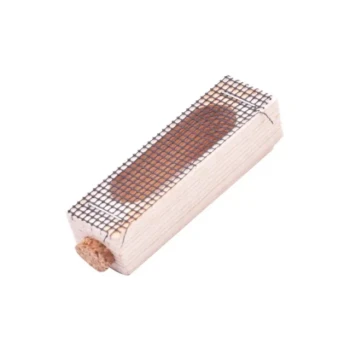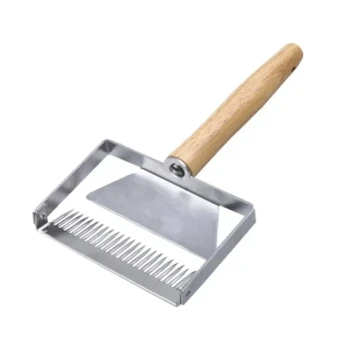For any beekeeper, marking a queen bee is one of the most effective management practices you can adopt. The primary benefits are making the queen incredibly easy to find during inspections, allowing you to track her age precisely, and giving you an immediate visual cue if the colony has replaced her through swarming or supersedure.
The core purpose of marking a queen isn't just about finding her faster; it's about transforming a routine hive inspection from a time-consuming search into a quick, data-driven assessment of your colony's health, stability, and productivity.

The Core Benefits of a Marked Queen
Marking a queen provides clear, actionable information at a glance. This simple dot of paint is a powerful tool for efficient and effective colony management.
Radically Improved Efficiency
Finding an unmarked queen in a hive of 50,000 bees can be a difficult and time-consuming task, especially for newer beekeepers.
A brightly colored mark on her thorax makes her stand out, often reducing the time it takes to locate her from many minutes to mere seconds.
This shortens the overall inspection time, which in turn reduces the disturbance and stress placed upon the colony.
Accurate Age Tracking
Beekeepers use an international color code system to mark queens based on the year they were born. This system provides an instant reference for her age.
A queen's age is a critical factor in colony health. Younger queens are typically more prolific egg-layers and produce more potent pheromones, which contribute to colony cohesion and reduce the likelihood of swarming.
Knowing her age helps you make proactive decisions about when to replace her, ensuring the colony remains strong and productive before her performance begins to decline.
Immediate Detection of Queen Events
If you open a hive and cannot find your marked queen but see a new, unmarked queen, you know a "queen event" has occurred.
This could mean the colony has swarmed (your original queen left with a portion of the bees) or performed a supersedure (the bees raised a new queen to replace a failing one).
This knowledge is vital. It confirms you have a new queen of unknown genetics and age, prompting you to assess her quality or decide if you need to introduce a new one with more desirable traits.
Understanding the Practical Implications
These core benefits translate directly into better beekeeping practices, leading to healthier hives and a more confident beekeeper.
Reduced Colony Stress
The longer a hive is open, the more the colony's temperature regulation, foraging, and internal tasks are disrupted.
Quickly finding the queen allows you to complete your inspection and close the hive faster, minimizing the overall stress on the bees.
Informed Management Decisions
A marked queen provides data that directly informs your actions. Seeing your marked queen confirms she is alive and accepted by the colony.
Tracking her age helps you plan for requeening before the hive's population and productivity decline. Detecting a supersedure allows you to intervene if necessary.
Increased Beekeeper Confidence
For new beekeepers, the simple act of confirming the queen is present provides immense peace of mind.
It makes inspections less intimidating and more focused, allowing you to learn and observe bee behavior without the anxiety of a prolonged search for the queen.
Common Pitfalls to Avoid
While the benefits are significant, marking a queen is a delicate procedure that carries some risk. Success depends on careful handling and the right technique.
Risk of Harming the Queen
The queen is the single most important bee in the colony, and she can be fragile. It is essential to use a light touch.
When capturing and holding her, whether by hand or with a marking cage, applying too much pressure can easily injure or kill her.
Potential for Hive Rejection
Proper marking is critical. The paint should be a small dot placed only on the thorax (the middle section of her body).
Getting paint on her eyes, antennae, wings, or joints can interfere with her senses and movement. If this happens, the other bees may perceive her as damaged and reject or kill her.
The Required Tools and Skill
Marking a queen requires a non-toxic, bee-specific marking pen or paint and often a marking tube or cage to hold her steady.
The process demands a calm demeanor and a steady hand. It is often wise for new beekeepers to practice on drones (male bees) first to build confidence and technique.
Making the Right Choice for Your Goal
Deciding to mark your queen depends on your beekeeping objectives.
- If your primary focus is efficiency and learning: Marking is an invaluable tool that saves time during every inspection and helps you build confidence quickly.
- If your primary focus is productivity and swarm prevention: Marking is a critical practice for tracking queen age and performance, allowing you to requeen proactively before problems arise.
- If you are managing multiple hives: Marking is nearly essential for effective record-keeping and making consistent, data-based management decisions across your apiary.
Ultimately, this simple dot of color provides a wealth of information that empowers you to be a more proactive and successful beekeeper.
Summary Table:
| Benefit | Key Outcome |
|---|---|
| Radically Improved Efficiency | Reduces queen-finding time from minutes to seconds, minimizing hive disturbance. |
| Accurate Age Tracking | Enables proactive requeening decisions based on the international color code system. |
| Immediate Detection of Queen Events | Provides a visual cue for swarming or supersedure, allowing for timely intervention. |
Ready to manage your apiary with confidence and precision?
As a beekeeper, you know that efficient tools and reliable data are key to a thriving operation. HONESTBEE supplies the high-quality beekeeping supplies and equipment—including safe, non-toxic queen marking kits—that commercial apiaries and distributors trust.
Let us help you boost your productivity and hive health. Contact our expert team today to discuss your wholesale needs and discover the HONESTBEE difference.
Visual Guide

Related Products
- Queen Bee Marking Pen POSCA Queen Marking Pens for Beekeeping Bee Markers
- Queen Bee Marking Pen UNI Medium Point for Queen and Bee Marking
- Queen Bee Marking Tube Cage Bottle Catcher Holder with Clear Plastic Plunger Marker
- Professional Engraved Round Hive Number Tags for Beekeeping
- Wholesales Dadant Size Wooden Bee Hives for Beekeeping
People Also Ask
- What should you do immediately after marking a bee? Ensure a Clean, Durable Mark with This Key Step
- What is the purpose of marking queen bees with colors? Essential for Hive Management & Efficiency
- What are the Queen marking colors associated with specific years? Master Hive Management with the 5-Year Color Code
- Where is the queen bee typically marked? A Guide to Safe & Effective Queen Identification
- What are the benefits of marking a Queen bee for hive management? Boost Efficiency & Colony Health



















